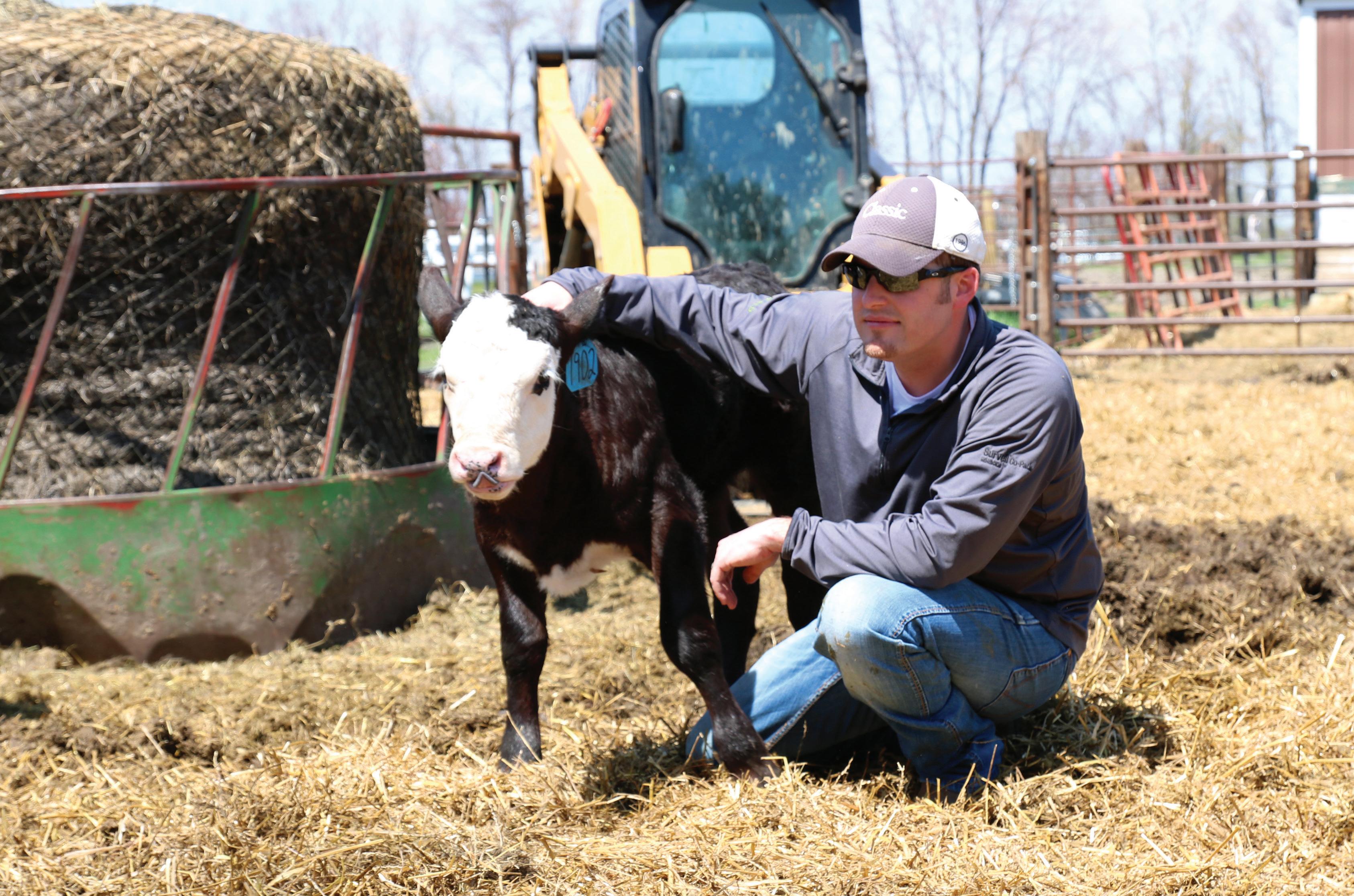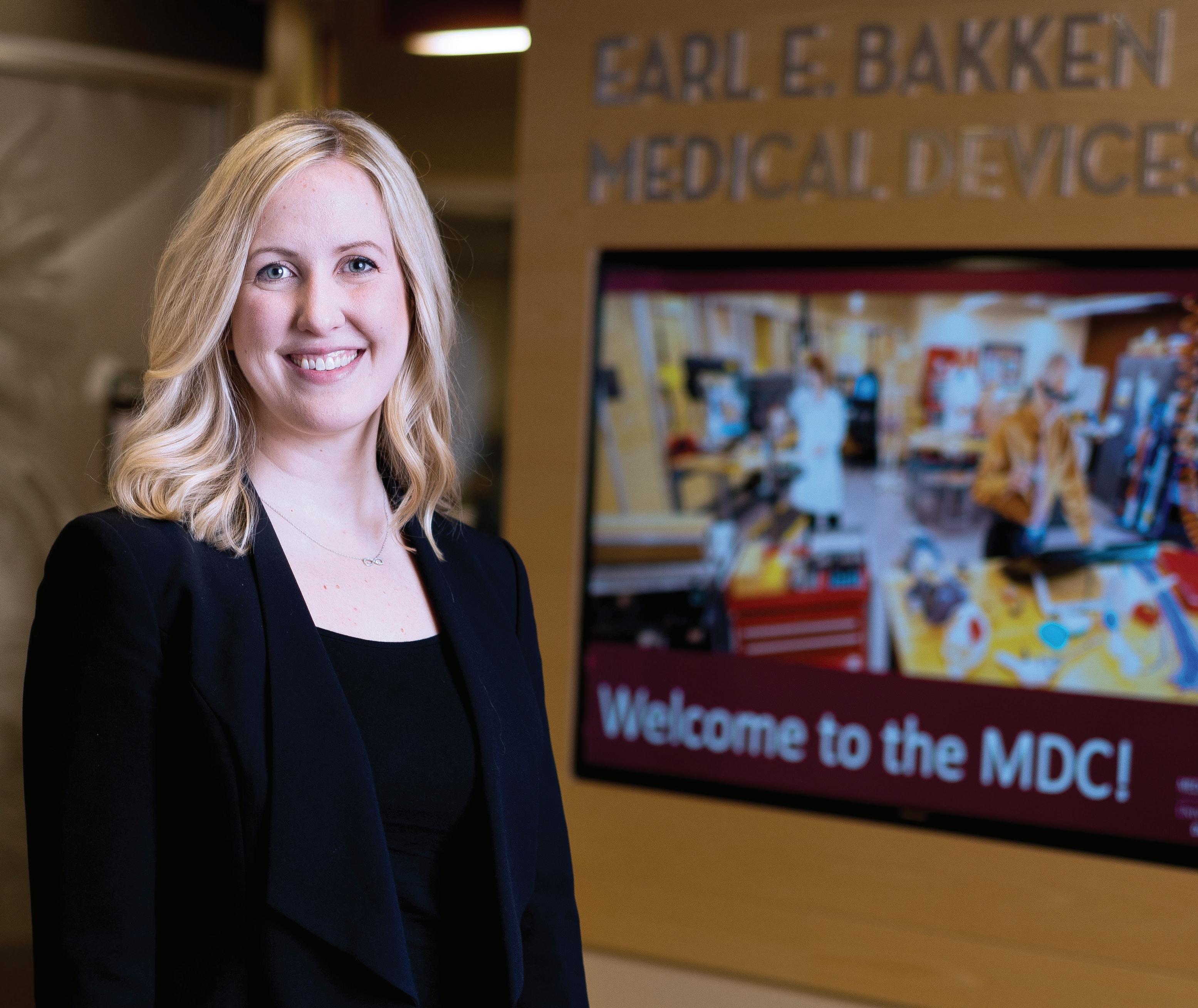
8 minute read
School News
ROOTED TO RURAL anesthesia care
After graduating from the School of Nursing, Casey Wangen headed home to Crookston to be a CRNA
by Brett Stursa
Trauma is everywhere and Crookston, Minnesota — a town of 8,000 located 100 miles from the Canadian border — is no different. As a nurse anesthetist at the local hospital, Casey Wangen, DNP ‘16, APRN, CRNA, knows that means his days are often high-stress and fast-paced. “It is a lot of adrenalin and requires fast-on-yourtoes thinking. It is very dynamic and changes by the minute. Your day can go from nothing to a 17-hour shift,” said Wangen. In one day he can see the full spectrum of life, resuscitating a premature newborn and then hours later be in surgery with a 99-year-old with a broken hip. “One day I am doing lots of regional anesthesia, or blocks, then I am doing lots of spinal anesthesia for knee or hip replacements,” said Wangen. “We get to do emergency cases, traumas, and we are in obstetrics helping with labor pains. Then 10 minutes later I can be in the ER stabilizing a person who just got crushed by a bull or got an arm taken off by a piece of farm equipment. Like, boom, just like that my day changed. I love the responsibility. No day is even close to the same. I like that.” Across rural America, Certified Registered Nurse Anesthetists (CRNAs) are the primary providers of anesthesia care. In Crookston, CRNAs are the only providers of anesthesia care. At the critical access hospital in town, RiverView Health, Wangen is one of four CRNAs that provide all the anesthesia services — including surgical anesthesia, pain management, vascular access and emergency services — for the 25-bed hospital with about a dozen surgeons. His work varies compared to that of peers he graduated with at the University of Minnesota, who largely practice in metro areas. “Their scope of practice is different than mine. I’m responsible for providing a variety of services throughout the entire hospital, whereas larger facilities have separate staff for different areas,” said Wangen. “Most of them are not doing regional anesthesia, like placing epidurals and spinal anesthetics, which is more the practice of their physician colleagues.” As a nurse anesthetist in rural Minnesota, he said he spends anywhere from 30 to 70 hours at the hospital each week. He leans on regional anesthesia, or blocks, which are easier to recover from and typically mean less opioids are prescribed in the end. “It is very personalized,” said Wangen. Wangen says that practicing in a small town means that he knows many of his patients.
continued on page 40
As a nurse anesthetist at the hospital in Crookston, Casey Wangen, DNP ‘16, APRN, CRNA, says his days are often high-stress and fast-paced.
continued from page 38
“In all of my training at the University of Minnesota, I would rarely see a patient again after a procedure,” said Wangen. “Here, in Crookston, I see them at the grocery store, at the bank or a sporting event. I see them at social outings, at restaurants. It was strange at first, but not anymore, since it happens all the time.”
BARN THERAPY Now a father of two, Wangen lives on a ranch just outside of town with his wife, children, cows, horses and baby chickens. “The barn is my therapy,” said Wangen. “I can be as strained and busy as ever at the hospital, but I know when I get home, I have to check on the horses and cows. As soon as I start with that, everything else just dissipates. It all goes away once I am out there.”

Crookston, sitting in the fertile Red River Valley, is a community built on agriculture. His family events can be held in a shop on a farmyard or might involve competing in rodeos. “I am just rooted here so deep,” said Wangen. “It is God’s country. The farm life, the culture here, it all just suits me.”
METRO EDUCATION READIED HIM FOR RURAL PRACTICE Wangen, who already had a bachelor’s degree in exercise physiology from Minnesota State University Moorhead, came to the University of Minnesota School of Nursing to earn a master’s degree. After earning his master’s degree in 2011, he practiced as an ICU nurse in a North Dakota hospital for two years before returning to the University of Minnesota to earn a Doctor of Nursing Practice degree.
• • • “It is a lot of adrenalin and requires fast-on-your-toes thinking. It is very dynamic and changes by the minute. Your day can go from nothing to a 17-hour shift.” – Casey Wangen, DNP ‘16, APRN, CRNA
As a student in the DNP nurse anesthesia program, he knew he’d have a variety of clinical experiences that would prepare him for a Crookston practice. “The U of M did a good job of setting up multiple rotations at different sites that are CRNA only, which really prepared me to do the work I am doing at Crookston now,” said Wangen. “I got to experience being in the city and I interacted with so many anesthesia providers, saw so many different techniques and used so many different medications in different ways.” Wangen knew when he applied to the nurse anesthesia program that he would return to Crookston to provide care. His family’s roots run deep in the area, with family who are farmers and others who are health care providers. “As soon as I graduated, we were northbound and the cityscape was in our rear view mirror,” said Wangen.”And I’ve never been happier.”
Same-day and next-day appointments at our Nurse Practitioners Clinics
With two convenient locations in the heart of Minneapolis, our Nurse Practitioners Clinics give you even more access to compassionate care for common conditions.
U of M Campus Clinics and Surgery Center 909 Fulton St. SE, Floor 5, Minneapolis, MN 55455 Call: 612-676-4580 Visit: MHealth.org Downtown Minneapolis 814 S. Third St. Minneapolis, MN 55415 Call: 612-676-4580 Visit: MHealth.org

Follow her LEAD
Amy Hoelscher, DNP ’17, BSN ’08, is carrying the legacy of nursing innovation forward
by Tom Ziemer
Before Amy Hoelscher, DNP, RN, CPXP, could inspire her fellow nurses about the future of the profession, she needed to ground herself in the past. So the two-time School of Nursing graduate returned to her alma mater in search of historical context for her presentation on cultivating creativity and innovation at this year’s Planting Seeds of Innovation Conference. As she paged through volumes of the American Journal of Nursing from the early 1900s, she saw scores of inventions created by nurses, from a device for heating bathtubs to a specialized stretcher for transporting patients with typhoid fever. Innovation, it turns out, is nothing new in nursing. “They saw a patient need and they created something to fix it,” she said. “We have this really rich history of being innovators that I didn’t know about.” As the first School of Nursing graduate to be selected into the Earl E. Bakken Medical Devices Center Innovation Fellows Program, Hoelscher is keen on carrying that legacy forward. The one-year, immersive Innovation Fellows Program brings together professionals from across health care, bioscience and engineering to create novel and needed medical devices and develop future leaders in the medical technology industry. It’s a fresh challenge for Hoelscher, who previously spent a decade as a nurse in the neonatal intensive care unit at Children’s Minnesota in Minneapolis. “I’m interested in innovation and how we can do health care differently,” said Hoelscher, who earned a Bachelor of Science in Nursing degree in 2008 and a Doctor of Nursing Practice degree in 2017. “What are things that we can work on?”
BEYOND BEDSIDE Hoelscher was perfectly content in the neonatal intensive care unit, where she loved witnessing the resilience of newborns and watching parents build confidence. But then a colleague encouraged her to participate in the hospital’s evidence-based practice scholars program, in which frontline staff explore issues that are relevant to their day-to-day work by researching academic literature. For Hoelscher, who researched the effects of lighting on babies in neonatal intensive care units, the experience tapped into her natural curiosity and left her wanting more. Her quest eventually led her to
• • • “Sometimes innovation might start with, ‘We have this cool new technology. How do we roll that out and where can it be useful?’” – Amy Hoelscher, DNP, RN, CPXP
the School of Nursing’s Doctor of Nursing Practice program, where she specialized in health innovation and leadership. “There’s a lot that I gained over those three years. Obviously the skills, knowledge and experiences to help move from bedside into other practices and the confidence to better lead health care into the future,” said Hoelscher.
SEEKING INNOVATION The thought of taking an idea for an innovation beyond a recommendation and into iterations of prototypes drew Hoelscher to the fellows program. She and the rest of her class — two biomedical engineers and two physicians — got a one-month crash course in the medical technology landscape, U.S. Food and Drug Administration regulations, potential investors and more. Then they visited area clinics, operating rooms and hospital units to identify gaps and opportunities. “Sometimes innovation might start with, ‘We have this cool new technology. How do we roll that out and where can it be useful?’” said Hoelscher, who’s specifically focusing on inpatient mobility for older adults. By design, each member of the interdisciplinary group of fellows approaches those clinical needs from a unique perspective. Hoelscher said working with and learning from the other fellows has been one of her favorite parts of the experience. “As much as I love bedside care and working with patients, part of getting my graduate degree was to be able to have a broader impact on patient care,” she said. “And whatever my next role is, I’ll be bringing that innovation component and championing it for nurses.”





